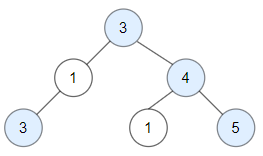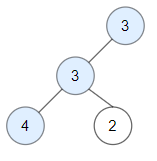Given a binary tree root, a node X in the tree is named good if in the path from root to X there are no nodes with a value greater than X.
Return the number of good nodes in the binary tree.
Example 1:

Input: root = [3,1,4,3,null,1,5] Output: 4 Explanation: Nodes in blue are good. Root Node (3) is always a good node. Node 4 -> (3,4) is the maximum value in the path starting from the root. Node 5 -> (3,4,5) is the maximum value in the path Node 3 -> (3,1,3) is the maximum value in the path.
Example 2:

Input: root = [3,3,null,4,2] Output: 3 Explanation: Node 2 -> (3, 3, 2) is not good, because "3" is higher than it.
Example 3:
Input: root = [1] Output: 1 Explanation: Root is considered as good.
Constraints:
- The number of nodes in the binary tree is in the range
[1, 10^5]. - Each node's value is between
[-10^4, 10^4].
class Solution { public int goodNodes(TreeNode root) { return help(root, -10001); } public int help(TreeNode root, int num){ if(root == null) return 0; int curmax = Math.max(root.val, num); return (root.val >= num ? 1: 0) + help(root.left, curmax) + help(root.right, curmax); } }
preorder遍历,找出遍历至今的当前最大curmax,和root.val比较,然后继续preorder